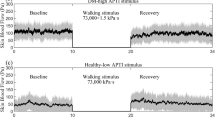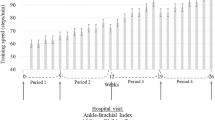Abstract
The objective of the present case study was to examine the therapeutic effects of thermal biofeedback-assisted autogenic training on a patient with non-insulin-dependent diabetes mellitus (NIDDM), vascular disease, and symptoms of intermittent claudication. The patient received thermal biofeedback from the hand for five sessions, then from the foot for 16 sessions, while hand and foot skin temperature were monitored simultaneously. In addition, the patient was instructed in autogenic training and practiced daily at home. Follow-up measurements were taken at 12 and 48 months. Within-session foot temperature rose specifically in response to foot temperature biofeedback and starting foot temperature rose between sessions. Posttreatment blood pressure was reduced to a normal level. Attacks of intermittent claudication were reduced to zero after 12 sessions and walking distance increased by about a mile per day over the course of treatment. It would appear that thermal biofeedback and autogenic training are potentially promising therapies for persons with diabetes and peripheral vascular disease.
Similar content being viewed by others
References
Budzynski, T. H. (1974).Relaxation training program. New York: BMA Audio Cassettes.
Cox, D. J., & Thomas, D. (1980). Treatment specificity of biofeedback training for primary idiopathic Raynaud's: A preliminary report.Behavioral Engineering, 6, 123–126.
Freedman, R. R. (1991). Physiological mechanisms of temperature biofeedback.Biofeedback and Self-Regulation, 16, 95–115.
Grabowska, M. J. (1971). The effect of hypnosis and hypnotic suggestion on blood flow in the extremities.Polish Medical Journal, 10, 1044–1051.
Greenspan, K. (1978). Biologic feedback and cardiovascular disease.Psychosomatics, 19, 725–737.
Greenspan, K., Lawrence, P. F., Esposito, D. B., & Voorhees, A. B. (1980). The role of biofeedback and relaxation therapy in arterial occlusive disease.Journal of Surgical Research, 29, 387–394.
Kazdin, A. E. (1982).Single-case research designs: Methods for clinical and applied settings. New York: Oxford University Press.
Luthe, W., & Schultz, J. H. (1969).Autogenic therapy. New York: Grune & Stratton.
Rice, B. I., & Schindler, J. V. (1992). Effect of thermal biofeedback-assisted relaxation training on blood circulation in the lower extremities of a population with diabetes.Diabetes Care, 15, 853–858.
Surwit, R. S. (1982). Behavioral treatment of Raynaud's syndrome in peripheral vascular disease.Journal of Consulting and Clinical Psychology, 50, 922–932.
Author information
Authors and Affiliations
Additional information
Preparation of this article was supported in part by NIDDK grant No. R0128288 and the Commonwealth of Virginia Diabetes Clinical Research Institute.
Rights and permissions
About this article
Cite this article
Saunders, J.T., Cox, D.J., Teates, C.D. et al. Thermal biofeedback in the treatment of intermittent claudication in diabetes: A case study. Biofeedback and Self-Regulation 19, 337–345 (1994). https://doi.org/10.1007/BF01776733
Issue Date:
DOI: https://doi.org/10.1007/BF01776733




